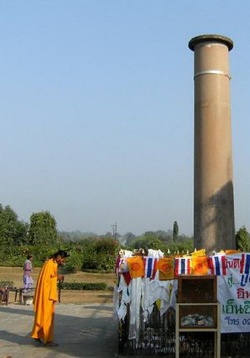Lumbini
Lumbini
藍毘尼 (Skt, Pali; Jpn Rambini) Lumbini: The site of the Buddha's birth near Kapilavatthu in Nepal. One of the four pilgrimage sites mentioned in the Mahaparinibbana Sutta.
The birthplace of Shakyamuni. Buddhist scriptures often refer to it as Lumbini Gardens. It was a grove in what is today the village of Rummindei just inside the southern border of Nepal. Lumbini is one of the four sacred sites connected with Shakyamuni, the other three being Buddhagaya(the place of his Enlightenment), Deer Park (the place of his first sermon), and Kushinagara (the site of his Death, or entry into Nirvana). The remains of Lumbini were discovered at Rummindei in 1896, and inscriptions on the stone pillar found there show that King Ashoka made a Pilgrimage to Lumbini and erected the pillar to commemorate Shakyamuni Buddha's birthplace. Hsüan-tsang, a Chinese priest who visited the site of Lumbini in the seventh century, said in his travel records that lightning had broken the pillar, and only the lower half remained. According to Buddhist legend, Maya gave birth to Shakyamuni here when she reached for a branch of an Ashoka tree to obtain its blossoms.
Lumbinī (Sanskrit: लुम्बिनी, "the lovely") is a Buddhist Pilgrimage site in the Rupandehi district of Nepal. ,. It is the place where Queen Mayadevi gave birth to Siddhartha Gautama, who as The Buddha Gautama founded the Buddhist tradition. The Buddha lived between roughly 563 and 483 BCE. Lumbini is one of four magnets for Pilgrimage that sprang up in places pivotal to the life of the Buddha, the others being at Kushinagar, Bodh Gaya and Sarnath.
Lumbini was where The Buddha lived until the age of 29. Lumbini has a number of temples, including the Mayadevi temple, and others under construction. Also located here is the Puskarini or Holy Pond where The Buddha's mother took the Ritual dip prior to his birth and where he, too, had his first bath, as well as the remains of Kapilavastu palace. At other sites near Lumbini, earlier Buddhas were, according to tradition, born, achieved ultimate Awakening and finally relinquished earthly Form.
In The Buddha's time, Lumbini was situated between Kapilavastu and Devadaha Nepal. It was there that The Buddha was born. A pillar now marks the spot of Asoka's visit to Lumbiní. According to an inscription on the pillar, it was placed there by the people then in charge of the park to commemorate Asoka's visit and gifts. The park was previously known as Rummindei, two miles north of Bhagavanpura.
In the Sutta Nipáta (vs. 683) it is stated that The Buddha was born in a village of the Sákyans in the Lumbineyya Janapada. The Buddha stayed in Lumbinívana during his visit to Devadaha and there preached the Devadaha Sutta.
Re-discovery
In 1896 Nepalese archaeologists (effort by Khadga Samsher Rana) discovered a great stone pillar at the site attributed to Ashoka. It is believed that the pillar was established by the great king Ashoka in about 245 BC. Records made by the Chinese pilgrim Faxian were also used in the process of identifying this religiously acclaimed site.
Lumbini, as of 1997, is a UNESCO World Heritage Site specifically nominated for the international World Heritage program.
The present Lumbini is divided into an ratio of 1:3 which means it is 3 km (2 mi) long for every 1 km (1 mi) wide. In total it's 2 km (1 mi) by 6 km
The holy site of Lumbini is bordered by a large monastic zone in which only Monasteries can be built, no shops, hotels or restaurants. It is separated into an eastern and western monastic zone, the eastern having the Theravadin Monasteries, the western having Mahayana and Vajrayana Monasteries.
The holy site of Lumbini has ruins of ancient Monasteries, a sacred Bodhi tree, an ancient bathing pond, the Asokan pillar and the Mayadevi temple, where the precise place of birth of Buddha is located. From early morning to early evening, pilgrims from various countries perform Chanting and Meditation at the site.
A Non-governmental organization called "Asia Pacific Exchange and Cooperation Foundation" (APECF) backed by chairman of the Unified Communist Party of Nepal (Maoist) and then Prime Minister Prachanda, the Chinese government and a UN group called "United Nations Industrial Development Organization" (UNIDO) signed a deal to develop Lumbini into a "special development zone" with funds worth $3 billion. The venture was a China-UN joint project. A broader 'Lumbini Development National Director Committee' under the Leadership of Pushpa Kamal Dahal was formed on October 17, 2011. The six-member committee included Communist Party of Nepal (Unified Marxist-Leninist) leader Mangal Siddhi Manandhar, Nepali Congress leader Minendra Rijal, Forest Minister Mohammad Wakil Musalman, among other leaders. The committee was given the authority to "draft a master plan to develop Lumbini as a peaceful and tourism area and table the proposal" and the responsibility to gather international support for the same.
Hindus regard The Buddha as an incarnation of Vishnu and thousands of Hindu pilgrims come here on the full moon of the Nepali month of Baisakh (April–May) to worship Maya Devi as Rupa Devi, the mother goddess of Lumbini.
